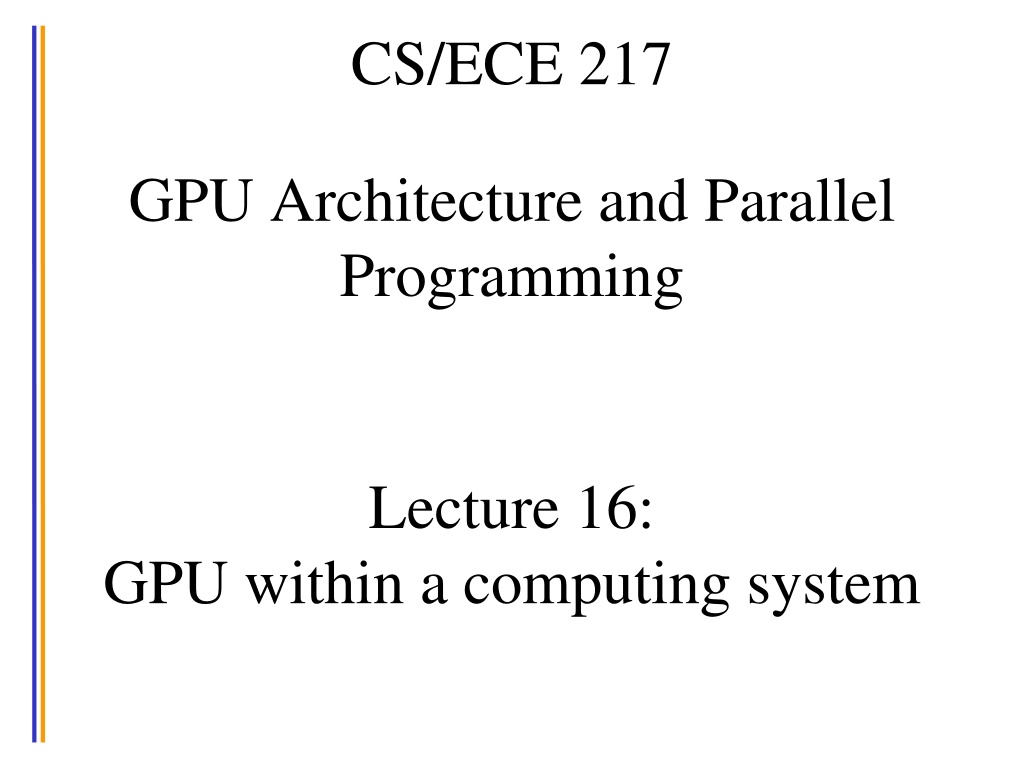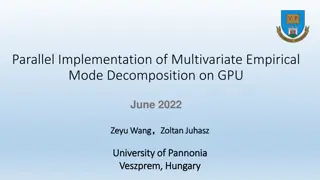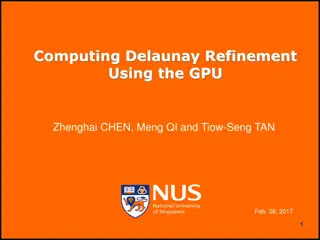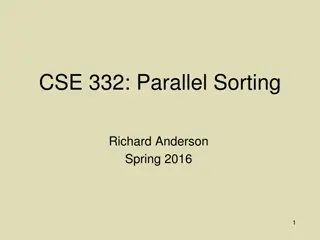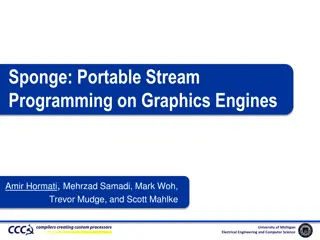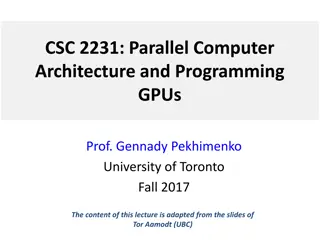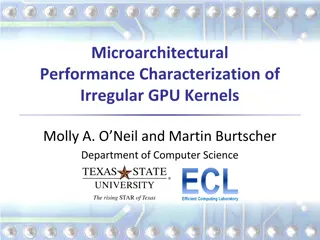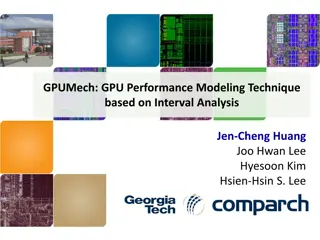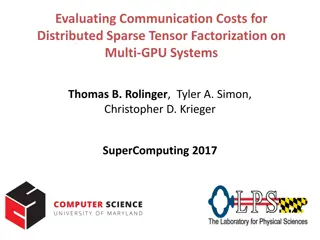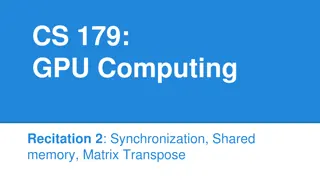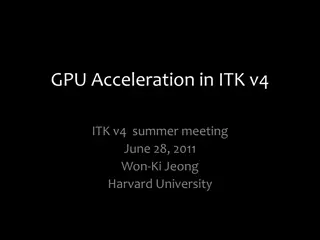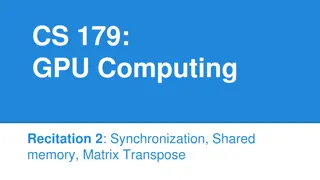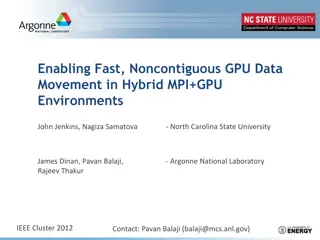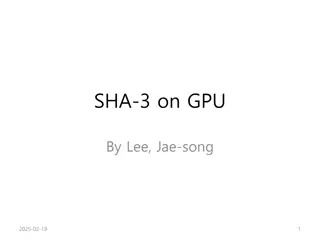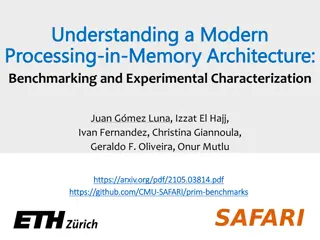GPU Architecture and Parallel Programming
Delve into the world of GPU architecture and parallel programming with Lecture 16 of CS/ECE.217. Understand the vital role of GPUs within computing systems and explore their efficient utilization for enhanced performance in a variety of applications.
Download Presentation

Please find below an Image/Link to download the presentation.
The content on the website is provided AS IS for your information and personal use only. It may not be sold, licensed, or shared on other websites without obtaining consent from the author.If you encounter any issues during the download, it is possible that the publisher has removed the file from their server.
You are allowed to download the files provided on this website for personal or commercial use, subject to the condition that they are used lawfully. All files are the property of their respective owners.
The content on the website is provided AS IS for your information and personal use only. It may not be sold, licensed, or shared on other websites without obtaining consent from the author.
E N D
Presentation Transcript
CS/ECE 217 GPU Architecture and Parallel Programming Lecture 16: GPU within a computing system
Objective To understand the major factors that dictate performance when using GPU as an compute co-processor for the CPU The speeds and feeds of the traditional CPU world The speeds and feeds when employing a GPU To form a solid knowledge base for performance programming in modern GPU s
Review- Typical Structure of a CUDA Program Global variables declaration Function prototypes __global__ void kernelOne( ) Main () allocate memory space on the device cudaMalloc(&d_GlblVarPtr, bytes ) transfer data from host to device cudaMemCpy(d_GlblVarPtr, h_Gl ) execution configuration setup kernel call kernelOne<<<execution configuration>>>( args ); transfer results from device to host cudaMemCpy(h_GlblVarPtr, ) optional: compare against golden (host computed) solution Kernel void kernelOne(type args, ) variables declaration - __local__, __shared__ automatic variables transparently assigned to registers or local memory syncthreads() repeat as needed
Bandwidth Gravity of Modern Computer Systems The Bandwidth between key components ultimately dictates system performance Especially true for massively parallel systems processing massive amount of data Tricks like buffering, reordering, caching can temporarily defy the rules in some cases Ultimately, the performance falls back to what the speeds and feeds dictate
Classic PC architecture Northbridge connects 3 components that must be communicate at high speed CPU, DRAM, video Video also needs to have 1st- class access to DRAM Previous NVIDIA cards are connected to AGP, up to 2 GB/s transfers Southbridge serves as a concentrator for slower I/O devices CPU Core Logic Chipset
(Original) PCI Bus Specification Connected to the southBridge Originally 33 MHz, 32-bit wide, 132 MB/second peak transfer rate More recently 66 MHz, 64-bit, 528 MB/second peak Upstream bandwidth remain slow for device (~256MB/s peak) Shared bus with arbitration Winner of arbitration becomes bus master and can connect to CPU or DRAM through the southbridge and northbridge
PCI as Memory Mapped I/O PCI device registers are mapped into the CPU s physical address space Accessed through loads/ stores (kernel mode) Addresses are assigned to the PCI devices at boot time All devices listen for their addresses
PCI Express (PCIe) Switched, point-to-point connection Each card has a dedicated link to the central switch, no bus arbitration. Packet switches messages form virtual channel Prioritized packets for QoS E.g., real-time video streaming
PCIe 2 Links and Lanes Each link consists of one or more lanes Each lane is 1-bit wide (4 wires, each 2-wire pair can transmit 2.5Gb/s in one direction) Upstream and downstream now simultaneous and symmetric Each Link can combine 1, 2, 4, 8, 12, 16 lanes- x1, x2, etc. Each byte data is 8b/10b encoded into 10 bits with equal number of 1 s and 0 s; net data rate 2 Gb/s per lane each way. Thus, the net data rates are 250 MB/s (x1) 500 MB/s (x2), 1GB/s (x4), 2 GB/s (x8), 4 GB/s (x16), each way
8/10 bit encoding Goal is to maintain DC balance while have sufficient state transition for clock recovery The difference of 1s and 0s in a 20-bit stream should be 2 There should be no more than 5 consecutive 1s or 0s in any stream 00000000, 00000111, 11000001 bad 01010101, 11001100 good Find 256 good patterns among 1024 total patterns of 10 bits to encode an 8-bit data A 25% overhead
PCIe PC Architecture PCIe forms the interconnect backbone Northbridge/Southbridge are both PCIe switches Some Southbridge designs have built-in PCI-PCIe bridge to allow old PCI cards Some PCIe I/O cards are PCI cards with a PCI-PCIe bridge Source: Jon Stokes, PCI Express: An Overview http://arstechnica.com/article s/paedia/hardware/pcie.ars
GeForce 7800 GTX Board Details SLI Connector Single slot cooling sVideo TV Out DVI x 2 256MB/256-bit DDR3 600 MHz 8 pieces of 8Mx32 16x PCI-Express
HyperTransport Feeds and Speeds Primarily a low latency direct chip-to-chip interconnect, supports mapping to board-to-board interconnect such as PCIe HyperTransport 1.0 Specification 800 MHz max, 12.8 GB/s aggregate bandwidth (6.4 GB/s each way) HyperTransport 2.0 Specification Added PCIe mapping 1.0 - 1.4 GHz Clock, 22.4 GB/s aggregate bandwidth (11.2 GB/s each way) HyperTransport 3.0 Specification 1.8 - 2.6 GHz Clock, 41.6 GB/s aggregate bandwidth (20.8 GB/s each way) Added AC coupling to extend HyperTransport to long distance to system-to-system interconnect Courtesy HyperTransport Consortium Source: White Paper: AMD HyperTransport Technology-Based System Architecture
PCIe 3 A total of 8 Giga Transfers per second in each direction No more 8/10 encoding but uses a polynomial transformation at the transmitter and its inverse at the receiver to achieve the same effect So the effective bandwidth is double of PCIe 2
PCIe Data Transfer using DMA DMA (Direct Memory Access) is used to fully utilize the bandwidth of an I/O bus DMA uses physical address for source and destination Transfers a number of bytes requested by OS Needs pinned memory Main Memory (DRAM) CPU Global Memory DMA GPU card (or other I/O cards)
Pinned Memory DMA uses physical addresses The OS could accidentally page out the data that is being read or written by a DMA and page in another virtual page into the same location Pinned memory cannot not be paged out If a source or destination of a cudaMemCpy() in the host memory is not pinned, it needs to be first copied to a pinned memory extra overhead cudaMemcpy is much faster with pinned host memory source or destination
Allocate/Free Pinned Memory (a.k.a. Page Locked Memory) cudaHostAlloc() Three parameters Address of pointer to the allocated memory Size of the allocated memory in bytes Option use cudaHostAllocDefault for now cudaFreeHost() One parameter Pointer to the memory to be freed
Using Pinned Memory Use the allocated memory and its pointer the same way those returned by malloc(); The only difference is that the allocated memory cannot be paged by the OS The cudaMemcpy function should be about 2X faster with pinned memory Pinned memory is a limited resource whose over-subscription can have serious consequences
Important Trends Knowing yesterday, today, and tomorrow The PC world is becoming flatter CPU and GPU are being fused together Outsourcing of computation is becoming easier
